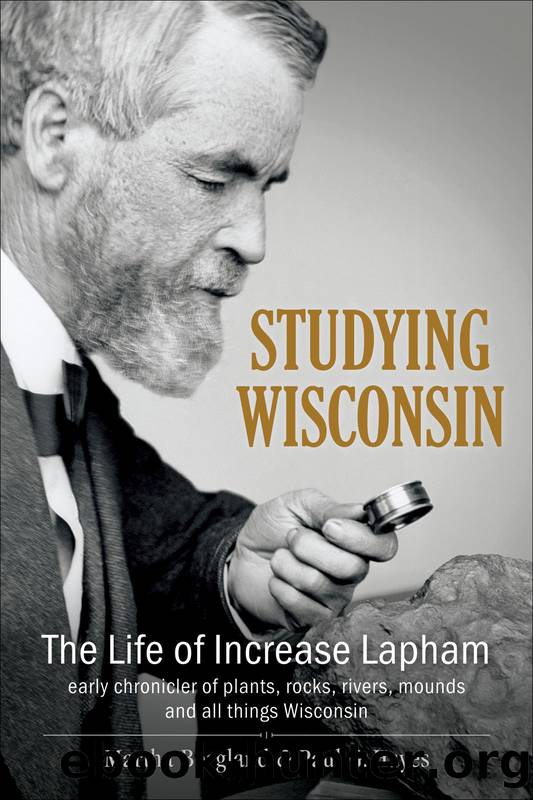Studying Wisconsin by Martha Bergland & Paul G. Hayes

Author:Martha Bergland & Paul G. Hayes
Language: eng
Format: epub
Publisher: Wisconsin Historical Society Press
Published: 2014-03-15T00:00:00+00:00
I thank you for your kind offer to collect specimens, and shall be pleased to correspond with you, especially so as I know you will meet with many very interesting plants in the region where you propose to reside. I would like to receive not only Grasses, which never come amiss in any quantity, but also all other plants you collect at Milwaukie. In return I will most readily give you any information, which my metropolitan situation enables me to command and will afford, in every way all the assistance in my power in your botanical pursuits. Let me entreat you to pay particular attention to my pets, the Grasses, etc, but donât neglect the others. I will see that you have due credit for any interesting discovery.27
Asa Grayâs letters to Increase Lapham were informal, generous, familiar, while Increaseâs letters to Gray were correct and somewhat stiff. Increase must have felt himself the student, the amateur in comparison to the more schooled Gray. But Increase did pay special attention to Grayâs pets, the grasses.
By 1842, Asa Gray was chairman and founder of the Botany Department at Harvard and in charge of the new botanic garden. He began to ask Increase to send live plants. âIn the fall can you send me live roots of your fine gentian, new species? That I may cultivate it in the Cambridge Botanic gardens, to see if it holds distinct from G. crinita?â28 And, Gray asks, could Lapham send roots of the pressed specimens he sent earlier, a dozen of each, including the new fringed gentian?29 Increase carefully packed in moss the roots of the plants Gray wanted and sent them in the fall. Gray wrote back the following spring thanking him for the plants, which arrived safely âexcept that the labels being written on paper, were destroyed by the moisture of the damp moss. . . . I trust the Iris lacustris will flower this spring that I may examine it.â30 Iris lacustris (dwarf lake iris) was one of the first plants Increase found in Milwaukee.
Asa Gray also sent live plants to Increase in the fall of 1844. All the plants were doing well, Increase wrote him, except for one Erica (heather). All the verbenas were alive in the greenhouse of his friend Mr. R. Woodward. âSuch has been the growth of the place, and the taste for the cultivation of flowers is such that we now have a public garden with a green house, in which many of the common house plants are cultivated and instead of putting the tender plants you sent into the cellar I have made arrangements to have them properly taken care of [there].31 Gray had also sent a Dr. Tuckerman to see Increase in the summer of 1844. Tuckerman, Increase wrote back, was âabout the only botanist I have met in Milwaukee, but I am just informed that Dr. Wunderly[,] a young German botanist, a friend of Prof. A. Braun is about to locate here, and if he
Download
This site does not store any files on its server. We only index and link to content provided by other sites. Please contact the content providers to delete copyright contents if any and email us, we'll remove relevant links or contents immediately.
Wondrous Transformations by Alison Li(681)
Madame Figaro by 27 Janvier 2023(627)
William Tryon and the Course of Empire by Paul David Nelson(432)
If Wishes Were Coffee by Moore Michelle(408)
Tabloid Love by Bridget Harrison(396)
Growing Up Underground by Steven Heller(374)
Against All Odds by Alex Kershaw(374)
Jacob H. Schiff by Naomi W. Cohen(356)
Nephew by M.K. Asante(332)
Against All Odds: A True Story of Ultimate Courage and Survival in World War II by Kershaw Alex(329)
The Missionary of Wall Street: From Managing Money to Saving Souls on the Streets of New York by Stephen F. Auth(322)
From Loyalists to Loyal Citizens by Valerie H. McKito(321)
Beware of Limbo Dancers by Reed Roy;(315)
Working on the Dock of the Bay by Michael D. Thompson(314)
Crossing Highbridge by Waters Maureen;(313)
Bronx by Jerome Charyn(307)
Growing Up with Clemente by Peterson Richard;(299)
Pioneer Mother by Hillary Brown(292)
Studying Wisconsin by Martha Bergland & Paul G. Hayes(291)
